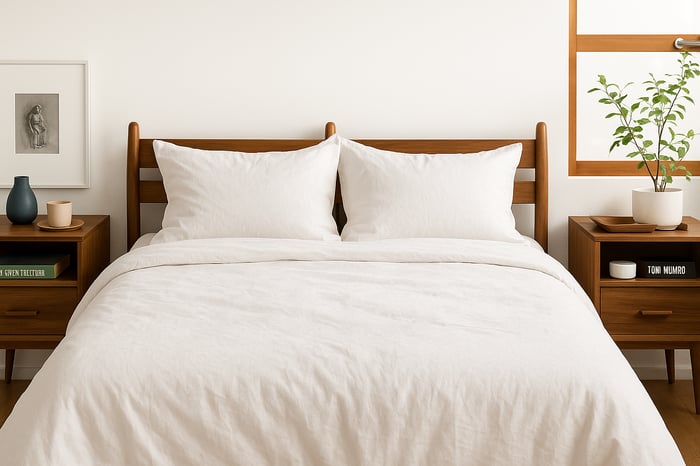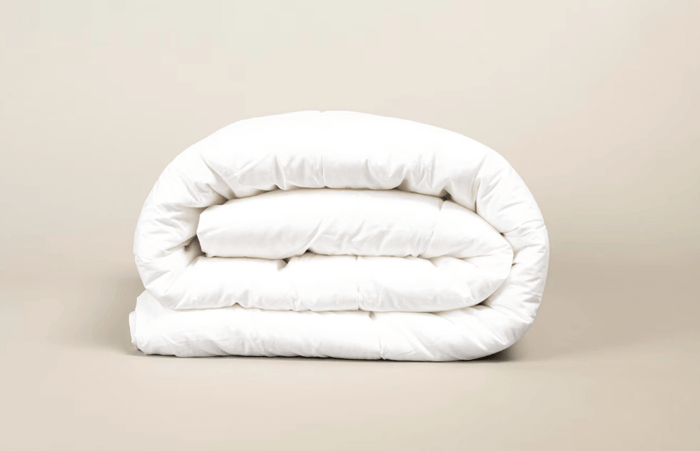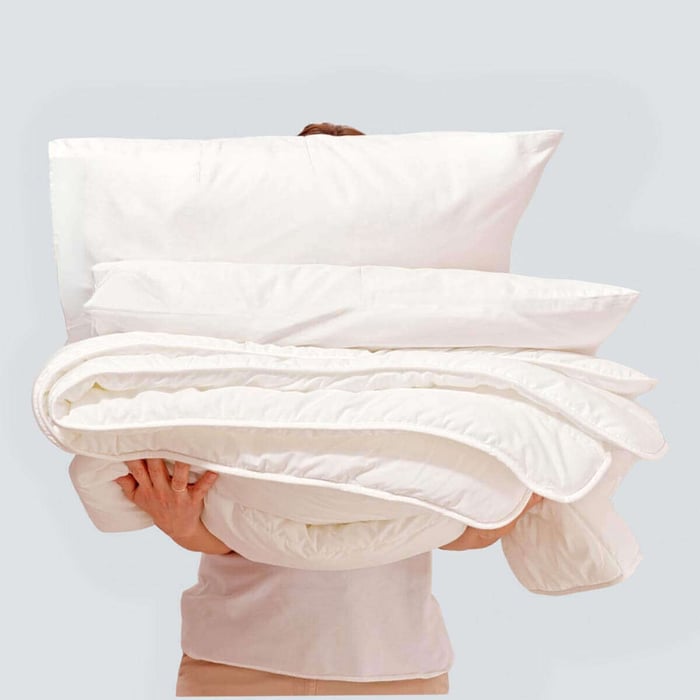Table of Contents
- Understanding How Cooling Duvets Work
- Bamboo Duvets: Smooth, Soft, and Cool to the Touch
- Wool Duvets: Nature’s Climate Control System
- Wool vs Bamboo Duvets: Side-by-Side Comparison
- The Regenerative Difference
- Comfort Beyond Cooling
- Sustainability Showdown
- Summary: Wool vs Bamboo Duvets at a Glance
- The Final Verdict
- FAQs on Wool Duvet Inserts, Comforters & Sustainable Bedding
If you’re comparing wool vs bamboo duvets, the winner for hot sleepers is clear — wool keeps you cooler for longer.
While bamboo feels instantly cool to the touch, wool comforters create a steady, breathable microclimate that prevents overheating and improves sleep quality.
So when it comes to choosing between wool vs bamboo duvets, let’s dive deeper to see why wool bedding outperforms bamboo when it comes to truly cooling comfort.
Understanding How Cooling Duvets Work
When you shop for the best cooling duvet, the goal isn’t to find something icy cold — it’s about temperature regulation.
A true cooling duvet should:
Wick away moisture before it pools.
Allow airflow through natural fibers.
Keep your temperature balanced, even as room conditions change.
Both bamboo and wool bedding outperform synthetic comforters. But the way they achieve cooling — and how long it lasts — is where the two diverge.
If you’re looking for cooler, drier nights, explore our Hot Sleepers Collection for breathable, moisture-wicking bedding.
Bamboo Duvets: Smooth, Soft, and Cool to the Touch
Bamboo duvets (or bamboo viscose duvets) are popular for their silky texture and eco-friendly reputation. So when it comes to wool vs bamboo duvets, there are some features that bamboo provides.
What You’ll Love
Instant cool feel – Bamboo fibers feel refreshingly cold at first contact.
Soft and drapey – Perfect if you prefer a lightweight, low-loft design.
Moisture-wicking – Helps absorb sweat in mild climates.
Vegan-friendly – An alternative to animal-derived fibers.
The Drawbacks
The issue? Most bamboo duvets are made from bamboo viscose, which is chemically processed, not purely natural.
That means:
The cooling effect fades as your body heat builds.
Moisture can get trapped in humid conditions.
The sustainability story is often overstated — the chemical process offsets bamboo’s fast growth.
Verdict: Nice Feel, Limited Cooling
If you’re looking for a wool vs bamboo duvets comparison, bamboo wins on smoothness but not on breathability or lasting coolness. It’s a good option for mild climates — but not for hot, humid nights.
Wool Duvets: Nature’s Climate Control System
But when it comes wool vs bamboo duvets for cooling properties, wool duvets have a unique ability to keep you cool when it’s hot and warm when it’s cold. That’s what makes them one of the best cooling duvets for hot sleepers.
Organic Wool Comforter | Made in New Zealand, Breathable All-Season Comfort

$342.00
$380.00
Sleep naturally better with our organic wool comforter Unlike down or synthetic comforters that trap heat, our spun wool design wicks away moisture and prevents overheating, so you stay cool & dry. Designed for deeper sleep with a gentle weight… Read more
Why Wool Excels at Cooling
Natural breathability – Air circulates between fibers to prevent trapped heat.
Moisture management – Wool absorbs up to 30% of its weight in vapor before feeling damp.
Temperature regulating – Wool fibers actively respond to your body’s heat and humidity.
Lightweight warmth – Unlike bulky synthetics, wool provides cozy insulation without smothering.
The Science Behind the Balance
Each wool fiber contains keratin and lanolin, helping it react to moisture and temperature changes. As your body warms, wool releases heat and vapor, preventing the clammy buildup that interrupts sleep.
This is what makes wool comforters for hot sleepers so effective — they adapt, minute by minute, to keep you comfortable.
 Discover how wool vs bamboo duvets compare in real life — breathable, natural, and designed for cooler nights and brighter mornings.
Discover how wool vs bamboo duvets compare in real life — breathable, natural, and designed for cooler nights and brighter mornings.Wool vs Bamboo Duvets: Side-by-Side Comparison
| Feature | Wool Duvet | Bamboo Duvet |
|---|---|---|
| Cooling Power | Active temperature regulating | Feels cool initially |
| Moisture Control | Absorbs vapor, releases it naturally | Surface-level wicking only |
| Breathability | Exceptional airflow | Moderate |
| Durability | 10+ years | 2–4 years |
| Eco Impact | Fully renewable, biodegradable | Chemically processed (viscose) |
| Texture | Soft loft with light hug | Silky, drapey, flatter profile |
| Best Use | Hot sleepers, all climates | Mild climates, low humidity |
When you compare wool vs bamboo duvets for temperature regulating bedding, wool wins for breathability, longevity, and sustainability.
The Regenerative Difference
At Antipodean Home, we don’t just use wool — we use regenerative wool from New Zealand farms that restore soil and biodiversity.
That means:
Healthier land and lower carbon footprint.
Wool that naturally breathes, cools, and biodegrades.
Comfort you can feel good about — for your body and the planet.
This is sustainable bedding that goes beyond “eco-friendly.” It’s regenerative, giving back to nature every night you sleep.
Comfort Beyond Cooling
A duvet isn’t just about temperature — it’s about how your body feels while you sleep.
Wool Comforters
Create a cloud-like, weightless hug.
Stay odor-free thanks to wool’s natural antibacterial properties.
Provide year-round comfort without swapping bedding each season.
Bamboo Comforters
Offer a sleek, silky touch that drapes beautifully.
Work best in mild or dry climates.
Require more frequent washing to avoid clumping.
Both have their place — but for temperature balance and durability, wool comforters offer more sustainable comfort over time.
If you’re looking for our full range of regenerative, organic bedding, explore our complete collection for everything you need to build a naturally healthier sleep sanctuary.
Sustainability Showdown
When choosing sustainable duvet materials, it’s important to look beyond marketing claims. True sustainability comes from materials like regenerative wool — fibers that are responsibly sourced, naturally biodegradable, and kind to the planet.
Let’s be honest — “sustainable bamboo” often sounds better than it is.
Most bamboo duvets are not made from raw bamboo fibers, but from chemically converted viscose. That process involves solvents that harm waterways and workers.
By contrast, regenerative wool comforters:
Come from sheep raised on healthy, biodiverse pastures.
Require minimal processing, no synthetics.
Are 100% biodegradable, creating no waste.
So, if you’re choosing sustainable bedding that’s also temperature regulating, wool is the clear front-runner.
If you’re looking for a cleaner, safer sleep environment, discover our Chemical-Free Collection crafted without harsh chemicals or toxins.
The Final Verdict
When it comes to bamboo vs wool bedding, the best cooling option is clear:
👉 Wool comforters outperform bamboo for breathability, moisture control, and long-term comfort.
If you struggle with night sweats or overheating, a wool comforter for hot sleepers delivers cooler nights, balanced warmth, and restorative rest.
FAQs on Wool Duvet Inserts, Comforters & Sustainable Bedding
Is bamboo cooler than wool?
Bamboo feels cooler at first touch, but wool stays cooler over time — thanks to active temperature regulation.
What’s the best cooling duvet for hot sleepers?
A wool comforter. It absorbs and releases heat naturally, helping you sleep dry and balanced through the night.
Are wool comforters hypoallergenic?
Yes — wool comforters are naturally hypoallergenic and naturally resistant to dust mites, mold, and mildew.
Are bamboo duvets good for summer?
Yes, but only in mild conditions. For temperature regulating bedding that works year-round, wool is more reliable.
Which is better for sustainability?
Regenerative wool, hands down. It restores ecosystems instead of depleting them.




